In Excel, information functions are used to obtain information about worksheets and their contents, such as the current row number, if a cell has an error, the type of value a cell has, and so on. Functions ISBLANK, ISERR, ISERROR, ISEVEN, ISFORMULA, ISLOGICAL, ISNA, ISNONTEXT, ISNUMBER, ISODD, ISREF, and ISTEXT are generally known as the IS functions, examines the provided value and returns TRUE or FALSE depending on the result.
Also read: Top 10 Trigonometric Functions for Complex Numbers in Excel
The 12 IS Functions in Excel
Let’s now talk about the different IS Functions in Excel and see how they are used with simple screenshots and references.
1. ISBLANK function
If a cell is blank, the ISBLANK function returns TRUE. In other words, the ISBLANK function allows you to refer to a cell and determine whether it is blank or not, and if it is blank, it returns TRUE otherwise the function returns FALSE.
Syntax: ISBLANK(value), where value is the data you want to test or the cell reference of the cell containing the data. The following examples show the use of ISBLANK function.

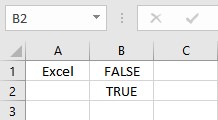
2. ISERR function
The Excel ISERR function determines whether a given expression or value yields any Excel error other than the #N/A error value. If this is the case, the function returns the logical value TRUE; otherwise, the ISERR function returns FALSE if the supplied value is not an error or is the #N/A error.
Syntax: ISERR(value), where value is the data you want to test or the cell reference of the cell containing the data. The following examples show the use of ISERR function:

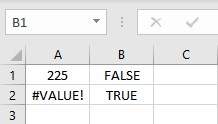
3. ISERROR function
If a given expression or value produces an Excel error, the Excel ISERROR function returns TRUE; otherwise, the function returns FALSE. It is an improved version of the ISERR function.
Syntax: ISERROR(value), where value is the data you want to test or the cell reference of the cell containing the data. The following examples show the use of ISERROR function:


4. ISEVEN function
If a specified integer or numeric expression evaluates to an even number, the Excel ISEVEN function returns TRUE; otherwise, the function returns FALSE.
Syntax: ISEVEN(value), where value is the data you want to test or the cell reference of the cell containing the data. The following examples show the use of ISEVEN function:

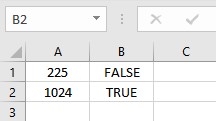
5. ISFORMULA function
The Excel ISFORMULA function determines whether a specified cell has a formula and returns TRUE if it does; otherwise, the function returns FALSE.
Syntax: ISFORMULA(value), where value is the data you want to test or the cell reference of the cell containing the data. The following examples show the use of ISFORMULA function:

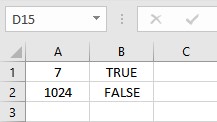
6. ISLOGICAL function
The Excel ISLOGICAL function determines whether a given value or expression returns a logical value. If this is the case, the function will return TRUE; otherwise, it will return FALSE.
Syntax: ISLOGICAL(value), where value is the data you want to test or the cell reference of the cell containing the data. The following examples show the use of ISLOGICAL function:


7. ISNA function
If a given expression or value returns the Excel #N/A error, the Excel ISNA function returns TRUE; otherwise, the function returns FALSE.
Syntax: ISNA(value), where value is the data you want to test or the cell reference of the cell containing the data. The following examples show the use of ISNA function:

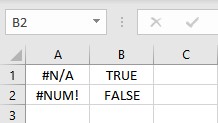
8. ISNONTEXT function
The Excel ISNONTEXT function determines whether a value supplied is text data or not. If not, the function returns TRUE; otherwise, the method returns FALSE. If the specified value is text, the function returns FALSE.
Syntax: ISNONTEXT(value), where value is the data you want to test or the cell reference of the cell containing the data. The following examples show the use of ISNONTEXT function:

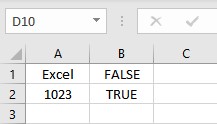
9. ISNUMBER function
The Excel ISNUMBER function determines whether a given value is a number. If this is the case, the function returns TRUE; otherwise, it returns FALSE.
Syntax: ISNUMBER(value), where value is the data you want to test or the cell reference of the cell containing the data. The following examples show the use of ISNUMBER function:

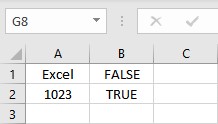
10. ISODD function
If a specified number or numeric expression evaluates to an odd number, the Excel ISODD function returns TRUE; otherwise, it returns FALSE.
Syntax: ISODD(value), where value is the data you want to test or the cell reference of the cell containing the data. The following examples show the use of ISODD function:

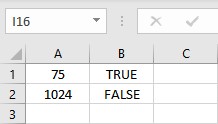
11. ISREF function
The Excel ISREF function determines whether or not a given value is a reference. The function returns TRUE if this is the case; otherwise, it returns FALSE.
Syntax: ISREF(value), where value is the data you want to test or the cell reference of the cell containing the data. The following examples show the use of ISREF function:
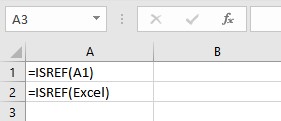
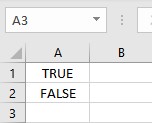
12. ISTEXT function
The Excel ISTEXT function determines whether a given value is text and returns TRUE if it is; otherwise, it returns FALSE.
Syntax: ISTEXT(value), where value is the data you want to test or the cell reference of the cell containing the data. The following examples show the use of ISTEXT function:

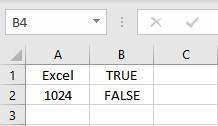
Conclusion
In this tutorial, we learned about different information functions in Excel.
References:
